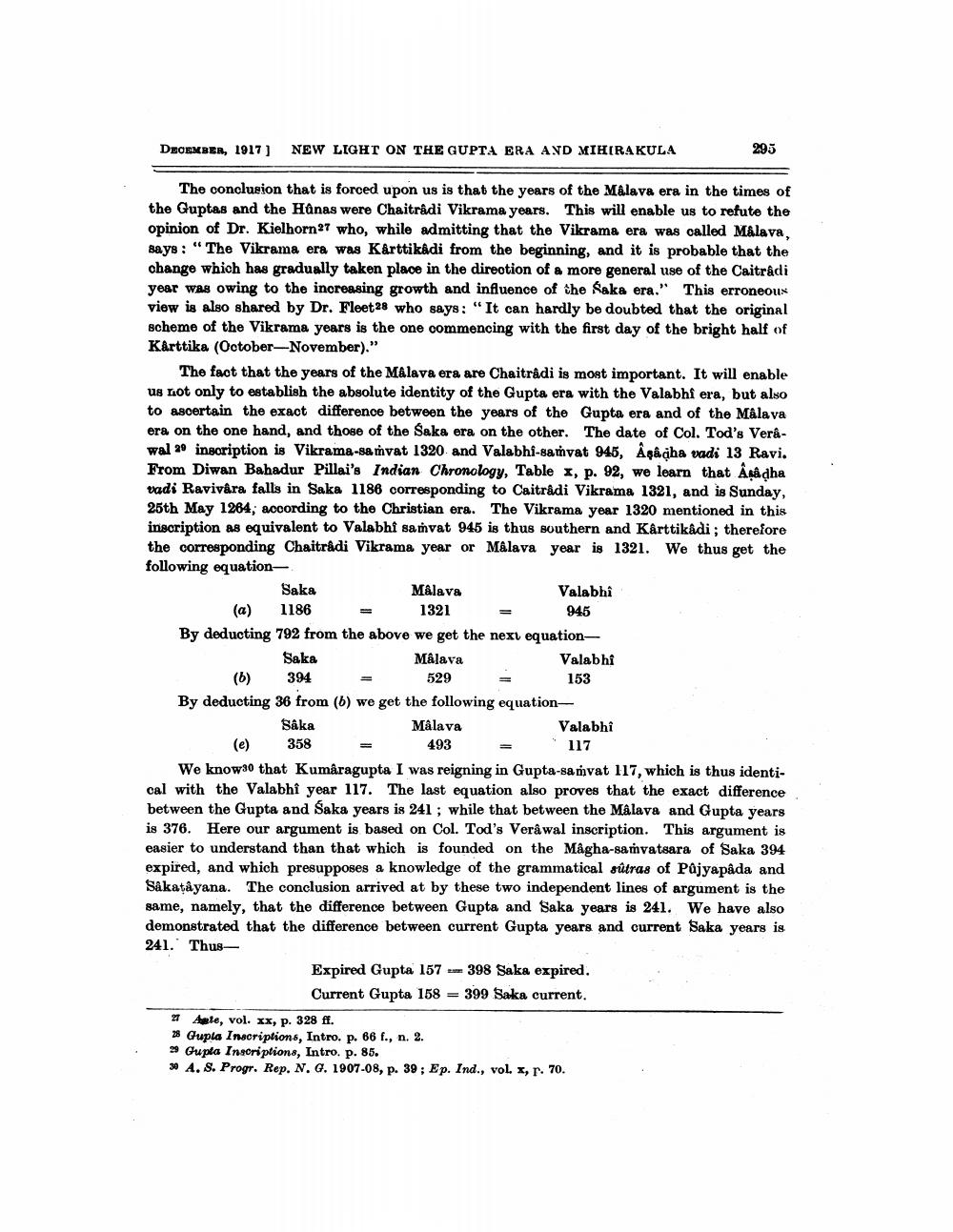________________
DECEMBER, 1917) NEW LIGHT ON THE GUPTA ERA AND MIHIRAKULA
295
The conclusion that is forced upon us is that the years of the Malava era in the times of the Guptas and the Hanas were Chaitrådi Vikrama years. This will enable us to refute the opinion of Dr. Kielhorn27 who, while admitting that the Vikrama era was called Málava, says: "The Vikrama era was Kärttikadi from the beginning, and it is probable that the change which has gradually taken place in the direction of a more general use of the Caitradi year was owing to the increasing growth and influence of the Kaka era." This erroneous view is also shared by Dr. Fleet 28 who says: "It can hardly be doubted that the original scheme of the Vikrama years is the one commencing with the first day of the bright half of Kárttika (October-November).”
The fact that the years of the Malava era are Chaitrādi is most important. It will enable us not only to establish the absolute identity of the Gupta era with the Valabhi era, but also to ascertain the exact difference between the years of the Gupta era and of the Malaya era on the one hand, and those of the Saka era on the other. The date of Col. Tod's Verâ - wal 20 insoription is Vikrama-samvat 1320 and Valabhi-samvat 945, Apagha vadi 13 Ravi. From Diwan Bahadur Pillai's Indian Chronology, Table 2, p. 92, we learn that Aadha radi Ravivêra falls in Saka 1186 corresponding to Caitradi Vikrama 1321, and is Sunday, 25th May 1264, according to the Christian era. The Vikrama year 1320 mentioned in this inscription as equivalent to Valabhi saṁvat 945 is thus southern and Karttikadi; therefore the corresponding Chaitrådi Vikrama year or Mâlava year is 1321. We thus get the following equation Saka Mâlava
Valabhi (a) 1186 = 1321 = 945 By deducting 792 from the above we get the nexı equationSaka Mâlava
Valabhi (6) 394 = 529 = 153 By deducting 36 from (b) we get the following equationSåka Mâlava
Valabhi (e) 358 = 493 = "117 We know that Kumâragupta I was reigning in Gupta-samvat 117, which is thus identical with the Valabhî year 117. The last equation also proves that the exact difference between the Gupta and Saka years is 241 ; while that between the Mâlava and Gupta years is 376. Here our argument is based on Col. Tod's Verâ wal inscription. This argument is easier to understand than that which is founded on the Magha-samvatsara of Saka 394 expired, and which presupposes a knowledge of the grammatical sutras of Pajyapada and Sakatayana. The conclusion arrived at by these two independent lines of argument is the same, namely, that the difference between Gupta and Saka years is 241. We have also demonstrated that the difference between current Gupta years and current Saka years is 241.' Thus
Expired Gupta 157 -- 398 Saka expired.
Current Gupta 158 = 399 Saka current. 21 Agte, vol. xx, p. 328 ff. 28 Gupta Inscriptions, Intro. p. 66 f., n. 2. 23 Gupta Inscriptions, Intro. p. 85. 30 A. S. Progr. Rep. N. G. 1907-08, p. 39; Ep. Ind., vol. x, r. 70.




